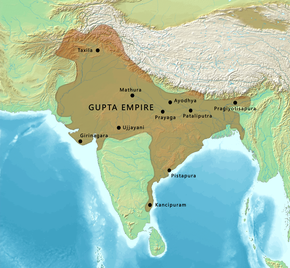Art & Culture, AWIP
Q. “The Gupta Age is often referred to as the Golden Age of ancient India.” Why?
- Introduction to the Gupta Era:
-
- The Gupta Empire emerged on the ruins of the Kushan and Satavahana empires.
- Their rule extended from approximately A.D. 335 to 455.
- The Guptas were initially feudatories of the Kushans in Uttar Pradesh.
- Their centre of power was at Prayag (modern-day Allahabad/ Prayag Raj).
- Golden Age of the Guptas:
The Gupta Age is often referred to as the Golden Age of ancient India. Let’s explore why:
-
-
- Polity:
- Gupta rulers achieved political unification after more than 500 years since the decline of the Mauryans.
- Strong and efficient rulers like Chandragupta I, Samudragupta, Chandragupta II, and Skandagupta ruled over extensive empires.
- Economy:
- The Gupta age witnessed economic prosperity.
- The Guptas issued the largest number of gold coins called “dinars”.
- Chinese traveler Fa-hien described Magadh (the power center of Gupta empire) as full of cities and wealthy people.
- Art and Literature:
- Gupta rulers were patrons of art and literature.
- Samudragupta was depicted on his coins playing the vina (a musical instrument).
- Chandragupta II supported nine luminaries in his court.
- Ajanta paintings, created during Gupta times, represent the finest specimens of Buddhist art.
- The great poet Kalidasa belonged to this age, and his work “Abhijnanashakuntalam” is highly regarded in world literature.
- Polity:
-
-
-
- Cultural Flourishing:
-
-
-
-
- The Gupta Age witnessed remarkable achievements in the fields of arts, literature, and culture. Temples, idols, and paintings from this period provide valuable insights into the artistic sensibilities of the time.
- The Gupta flag featured the mythological creature Garuda, symbolizing the empire’s Hindu roots.
- Science and Technology:
- Mathematician Aryabhata wrote the Aryabhatiya during this period, displaying awareness of the zero system and decimal system.
- Gupta craftsmen excelled in iron and bronze work.
-
-
-
-
- Social Developments:
-
-
-
-
- Land grants to Brahmanas continued, emphasizing their supremacy.
- Shudras gained more rights, including listening to the Ramayana, Mahabharata, and worshiping Krishna.
- Women from lower varnas were free to earn their livelihood.
-
-
-
-
- Religion and Tolerance:
-
-
-
-
- Buddhism no longer received royal patronage.
- Bhagavatism, centered around the worship of Vishnu or Bhagavat, gained prominence.
- Gupta kings followed a policy of religious tolerance.
-
-
-
-
- Political Unification:
- The Gupta Empire brought about political unification across the Indian subcontinent. Under rulers like Chandragupta I, the ancestral kingdom expanded into a vast and enduring empire.
- The Gupta rulers skilfully extended their political powers through strategic marriages, such as Chandragupta I’s union with the Lichchhavi princess Kumaradevi.
- Political Unification:
-
-
-
-
- Notable Gupta Rulers:
- Chandragupta I: The founding king who transformed the ancestral kingdom into an expansive empire. His reign lasted from 319 to 350 CE.
- Samudragupta: Known for military conquests, he extended the Gupta Empire from the Ravi River to the Brahmaputra River. Samudragupta was also a poet and musician.
- Chandragupta II (Vikramaditya): His reign marked the zenith of Gupta power. He defeated the Saka Western Kshatrapas and extended the empire westward. Hindu art, culture, and other religions flourished during his rule.
- Notable Gupta Rulers:
-
-
In summary, the Gupta period was marked by political unity, economic prosperity, artistic achievements, scientific advancements and social changes.


